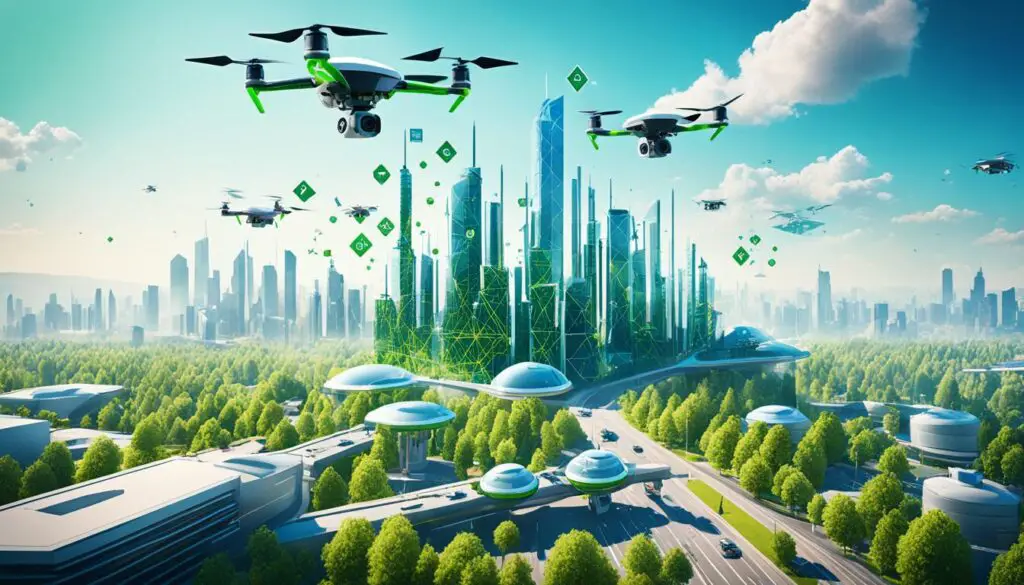
As our concern for the environment’s health grows, so does our need for innovative solutions to monitor and improve air quality. That’s where AI comes in. By harnessing the power of artificial intelligence, we are revolutionizing the way we understand and combat air pollution.
Air quality monitoring systems equipped with AI technology have proven to be game-changers. With machine learning algorithms and real-time data analysis, these solutions provide accurate and timely information about air quality levels, pollutant sources, and potential health risks. This enables us to make informed decisions and take proactive measures to mitigate air pollution, creating a healthier environment for everyone.
Key Takeaways:
- AI solutions are transforming air quality monitoring by providing accurate and real-time information.
- Machine learning algorithms enable in-depth analysis of air quality parameters and identification of pollutant sources.
- AI-powered systems offer automated alerts and notifications, facilitating timely actions to address pollution episodes.
- The future of AI in air quality monitoring holds promise for improved understanding and effective pollution control strategies.
- Integrating AI with emerging technologies like IoT and satellite imagery will enhance monitoring networks and interventions.
The Benefits of AI in Air Quality Monitoring
The integration of AI in air quality monitoring offers numerous benefits. Firstly, AI solutions can process vast amounts of data from various sensors and sources, allowing for comprehensive and real-time monitoring of air quality parameters such as particulate matter, ozone levels, and volatile organic compounds. This enables more accurate and granular analysis, helping us understand the precise sources and patterns of pollution.
Additionally, AI algorithms can identify trends and patterns in the data, which can be used to predict future air quality conditions and identify potential hotspots for pollution. With this advanced predictive capability, air quality monitoring efforts can be more targeted and focused.
AI-powered air quality monitoring systems can provide automated alerts and notifications to relevant authorities and individuals, enabling timely actions to be taken to address pollution episodes.
Moreover, the utilization of AI solutions enhances the effectiveness and efficiency of air quality monitoring by automating data collection, analysis, and reporting. This allows for faster decision-making and response to changing air quality conditions, leading to better environmental management and improved public health outcomes.
Overall, the integration of AI in air quality monitoring revolutionizes our ability to understand, predict, and mitigate the impact of air pollution on human health and the environment.
The Role of AI in Air Quality Monitoring
AI plays a crucial role in transforming air quality monitoring through its ability to process large datasets, identify patterns, and provide real-time insights. By automating tasks that were previously manual and time-consuming, AI enables more comprehensive and accurate monitoring of air quality parameters.
- Processing vast amounts of data from various sensors and sources.
- Real-time monitoring of air quality parameters.
- Predicting future air quality conditions and identifying pollution hotspots.
- Providing automated alerts and notifications to relevant authorities and individuals.
- Enhancing the effectiveness and efficiency of air quality monitoring.
Through these capabilities, AI solutions empower us to make informed decisions and take proactive measures to protect the environment and public health.

The Future of AI in Air Quality Monitoring
The future of AI in air quality monitoring looks promising. As technology continues to evolve, AI algorithms will become more sophisticated and capable of handling increasingly complex data sets. This will enable even more accurate and detailed analysis of air quality, providing valuable insights into the causes and impacts of pollution.
Furthermore, the integration of AI with other emerging technologies such as Internet of Things (IoT) devices and satellite imagery will allow for a more comprehensive and interconnected air quality monitoring network. This network will enable real-time data sharing and collaboration between different monitoring stations and stakeholders, leading to more effective pollution control strategies and interventions.
Additionally, AI-powered air quality monitoring systems can be integrated into smart cities and urban planning initiatives, enabling real-time adjustments to infrastructure and traffic management to reduce pollution levels. With ongoing advancements in AI technology, the future holds great potential for further enhancing our understanding of air quality and implementing effective measures to protect our environment and promote public health.
FAQ
How can AI solutions revolutionize air quality monitoring?
AI solutions have the ability to process large amounts of data from various sensors and sources, allowing for comprehensive and real-time monitoring of air quality parameters. By using machine learning algorithms and real-time data analysis, AI solutions can provide accurate and timely information about air quality levels, pollutant sources, and potential health risks.
What are the benefits of integrating AI in air quality monitoring?
The integration of AI in air quality monitoring offers numerous benefits. Firstly, AI solutions can provide more accurate and granular analysis, helping us understand the precise sources and patterns of pollution. Additionally, AI algorithms can identify trends and patterns in the data, which can be used to predict future air quality conditions and identify potential hotspots for pollution. Moreover, AI-powered air quality monitoring systems can provide automated alerts and notifications, enabling timely actions to be taken to address pollution episodes.
What does the future hold for AI in air quality monitoring?
The future of AI in air quality monitoring looks promising. As technology continues to evolve, AI algorithms will become more sophisticated and capable of handling increasingly complex data sets. The integration of AI with other emerging technologies such as Internet of Things (IoT) devices and satellite imagery will allow for a more comprehensive and interconnected air quality monitoring network. Additionally, AI-powered air quality monitoring systems can be integrated into smart cities and urban planning initiatives, enabling real-time adjustments to infrastructure and traffic management to reduce pollution levels.
Source Links
- https://syfeed.com/en-us/news-details/prince-harry-meghan-markle-to-receive-additional-security-for-future-nyc-visits-following-near-catastrophic-paparazzi-car-chase_87194847.html
- https://syfeed.com/us/news-details/lottery-jackpots-surpass-1-billion-as-californians-have-3-ways-to-become-a-millionaire-or-not_87194704.html
- https://syfeed.com/us/news-details/navalnys-body-arrived-at-church-to-clapping-and-chanting-from-mourners_87194094.html








